Around the World
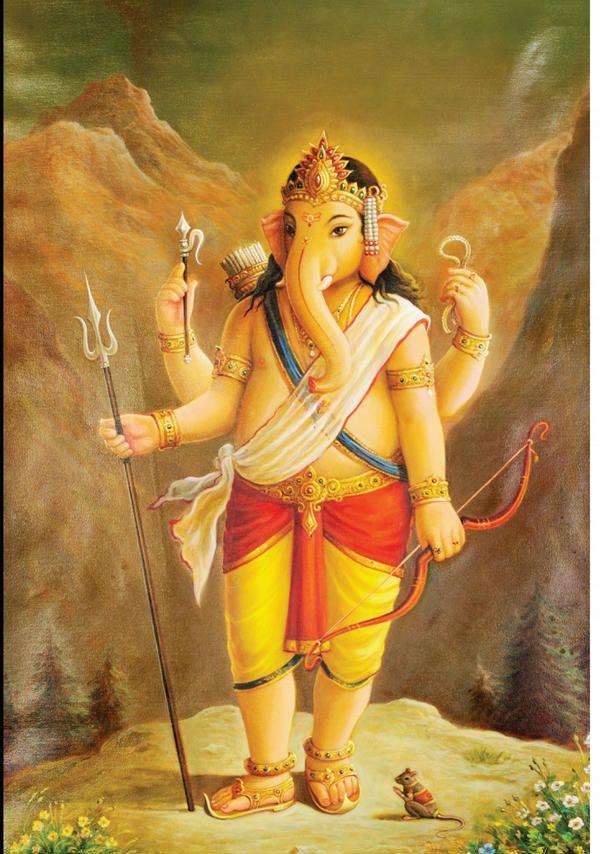
MAHA GANAPATI, OF COURSE, BELONGS TO ALL mankind, not to Hindus alone, though not all inhabitants of the planet call Him by our endearing name, Premavan Ganesha, which means “Loving Ganesha” in English. To the Chinese He is embodied in the form of a massive dragon, whose physical immensity depicts His incredible and irresistible force. To some Chinese He is Kuan-shi t’ien or Ho Tei, the large-bellied God of Happiness. To the Polynesians in Hawaii He is God Lono.
The South Indian and Sri Lankan Tamils call him by the affectionate term Pillaiyar, “Noble Child.” The Tibetans know Him as Ts’ogsbdag, and the Burmese worship Maha-Pienne. In Mongolia His name is Totkharour Khaghan. Cambodians offer worship to Prah Kenes, and the Japanese supplicate Vinayaksa or Sho-ten. By some He is envisioned as the feminine Mother Nature, and even nonbelievers seek to understand Him through personifying His great powers as Fate, Destiny or Numen. The ancient Egyptians may have known Him as a minor but very popular Deity, Bes, grotesque, pot-bellied and cheerful. The Romans called Him Janus and sought His blessings at the outset of any new venture. On His festival on the first of January (the month named after Him) He was treated with special cakes; mutual good wishes were exchanged and people made presents of sweets to one another for a good omen for the new year. In the West He is ubiquitous as the corpulent jolly Santa Claus, the dispenser of boons and gifts, especially to children, who knows our thoughts, words and deeds and bestows rewards accordingly. The Buddhists and Jains also honor Ganesha. In one form or another, He is honored throughout the world.
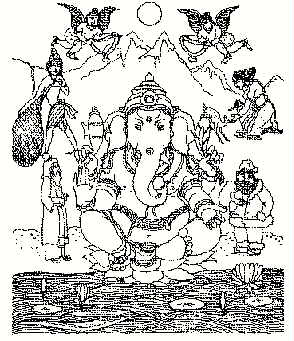
As respected author Ratna Ma Navaratnam, devotee of Sage Yogaswami of Sri Lanka, wrote: “Ganesha worship is most effective in illumining consciousness, and hence He is sought after and propitiated by the Saivites, Vaishnavites, Shaktas, Smartas, Kumaras, Jains and Buddhists as the Dispeller of Obstacles” (Aum Ganesha, The Peace of God, p. 176).
Hindus worship the great God Ganesha at countless pujas performed daily on every continent. In temples and home shrines Lord Ganesha is worshiped today in India, Sri Lanka, Nepal, Malaysia, Java, Bali, Borneo, Tibet, Myanmar, Siam, Afganistan, the Middle East, China, Indo-China, Japan, the Caribbean, Trinidad and Tobago, Hawaii and the Pacific Islands, Africa, Mauritius, Reunion, Europe, Australia, Canada, South America, the United States and elsewhere.
Every Hindu village and community has an image of the God Ganesha, and one of the many forms of Ganesha is found in every Hindu temple. The eminent scholar M. Arunachalam wrote, “Ganesha is usually installed at the entrance to the central sanctum, at the south, and also at the southwestern corner in the first court, of every Siva temple. Besides, He is placed on the first eastern goshta (niche) on the other southern wall of the ardha mandapa (secondary hall) in the dancing pose, known as Nartana Ganapati, in many temples. The tip of His trunk will curve to the left and touch the modaka, generally held in the left hand. In a few rare cases the trunk will curve to the right to touch the modaka on a right hand. Here He is called Valampuri (right turned) Vinayaga” (Festivals of Tamil Nadu, 1980, p. 112).
While Ganesha shrines are found at all Hindu temples, they often stand alone as well. They are often quite humble, not uncommonly a simple roadside shrine such as the one between Jaffna and Anuradhapura in Sri Lanka or along the roadsides here and there in South India. Here travelers stop to break a coconut and burn a bit of camphor before the Lord of Obstacles to pray for a safe and successful journey. There is a similar shrine near the university in Madras. Many years ago a young man discovered a tree that formed the shape of Ganesha head in its gnarled trunk. He began worshiping and soon took a vow not to leave the site. He has been there, serving as a priest and doing sadhana for several decades now, without leaving the tiny compound. Travelers and students about to take their exams come to the shrine to seek Lord Ganesha’s blessings. Such tree shrines enjoy the patronage of thousands of worshipers annually.
Historically His image is often found in places of danger, such as steep slopes, river crossings or where two roads cross. Here His murti may be a rough-hewn stone or even a trunk of a bo or banyan tree which has taken the form of the God Ganesha. A natural stone, or svayambhu (“self-created”) murti, may also be the object of worship. Researcher Alice Getty wrote: “The most celebrated svayambhu murtis of Ganesha are found in Kashmir, where there are three famous and most powerful formless stones which from ancient times have drawn pilgrims to their shrines. One, which is near the village of Ganesh-bal, is in the river Lidar near its right bank, and is still an important place of pilgrimage…. Another rock in Kashmir which has been worshiped from most ancient times as a symbol of Ganesha under the name of Bhimasvamin is at the foot of the hill Hari-Parbat near Srinagar…. The most remarkable of these svayambhu murtis in Kashmir is the one on a cliff along the Kishen-Ganga known as Ganesh-Gati” (Ganesha, a Monograph on the Elephant-Faced God, by Alice Getty, 1971, p. 22-23).
Perhaps the most famous Ganesha temple in India is the Uchi Pillaiyar Koyil at Trichy. Uchi means “at the top.” This large temple (also known as the Rock Fort Temple) is built on a hilltop and commands a breathtaking view of the city and of the river Kaveri. Another large Ganesha temple is the Pillaiyarpatti Temple near Karaikudi in Ramanathapuram District, also in Tamil Nadu. In New Delhi there is the Siddhi Buddhi Vinayagar temple situated in Vinayanagar. The Mukkuruni Pillaiyar inside the huge Meenakshi Temple complex in Madurai, India, is also quite famous. This murti is ten to twelve feet tall. Mukkuruni refers to a large measure of rice (about forty pounds). Here the priests cook a huge modaka ball for Ganesha using this measure. Hence the name Mukkuruni Pillaiyar. Also in Madurai, Lord Ganesha is worshiped as Vyaghrapada Ganeshani, in female form with tiger feet. The Ganeshani murti in sukhasana pose resides at Suchindram. There are two other temples in India with the female Ganesha form. One is at a tenth-century temple dedicated to sixty-four yoginis in Bheraghat, a village near Jabalpur. The other is the Tanumalaya Swami Temple in Suchindrum, Kerala. In Tibet She is worshiped as Gajanani.
A five-headed Ganesha mounted on a lion resides at Nagapattinam. At Vellore, India, Ganesha is enshrined as Valampuri Vinayakar, with his trunk turned to the right instead of to the left. This murti is considered very auspicious. Highly revered Ganesha shrines are also found in the precincts of the Siva temple of Tirunelveli, in the Kanyakumari temple at the southern tip of India, and in Rameshvaram and Chidambaram. Our loving Ganesha is especially beloved in Maharashtra, where eight temples form one of His most sacred pilgrimages, and dozens of other sites are designated for his adoration. At the end of this chapter we offer a list of fifty of India’s most prominent Ganesha citadels. It is said that to make a visit on hardship pilgrimage (third-class on trains, on foot or by crawling) to 108 Ganesha temples and roadside shrines is most auspicious to smooth out the karmas of the future by dissolving, through His grace, the negative karmas and mistakes of the past, made knowingly or unknowingly. Penance of this sort deliberately condenses into a short period, or puts all in one place, the suffering that would otherwise be encountered over a long span of time.
The garden island of Sri Lanka has fourteen well-known Ganesha temples. There is an unusual Vinayaka at the Siva temple in Central Java, which is presently an archeological tourist site being restored by the Indonesian government. Lord Ganesha here sits with the soles of His feet pressed together, much like a child would sit, or as a yogi would sit in deep samadhi.
Shri H. Krishnamurthi writes in Tattvaloka (Feb.-March 1990): “Several images of Ganesha have been discovered in the excavations of Central America and Mexico. It is said that in Mexico the name of Ganesha is Virakosha.” Recently India’s Birla Science Institute announced a new find: “A piece of evidence was connected with the legend of Ganesha’s writing down the epic to the dictation of Vyasa. A metal plate depicting the elephant-headed Deity holding an etching stylus has been found in Luristan in Western Iran and has been dated to around 1200 BCE (Motilal Banarsidass Newsletter Dec. 1993).”
Among the most renowned of Ganesha’s temples in Malaysia are the Siddhi Vinayagar temple of Petaling Jaya and the Kotta Malai Pillaiyar Temple of Kuala Lumpur on the busy street of Paduraya. The latter is a small temple, but extremely powerful, said to be the most popular Ganesha temple in the land. Also notable are the Jalan Pudu (Pasar Road) Pillaiyar Temple and the Poyyata Vinayagar Temple of Melaka. In Hawaii our Kadavul Hindu Temple for monastics and initiated members has a three-ton, six-foot-tall Ganesha. At the Saiva Dharmashala at Riviere du Rempart, Mauritius, we have dedicated a Spiritual Park and erected a grand mandapam around a five-ton, nine-foot tall, five-faced murti of Ganesha, Panchamukha Ganapati, in a mango grove. In Edmonton, Canada, New Zealand and Nandi, Fiji, Seattle, Salt Lake City, Bethesda, Denver, Scottsdale, Sebastian, Anchorage and Chicago there are exquisite stone murtis of the elephant-faced God, gifted by my aadheenam to the born Hindu communities, conferring blessings for new temples. In Great Britain Ganesha is enshrined at each of the nation’s several new temples and is the presiding Deity at the Shree Ganapati Temple in Wimbledon and at temples in Switzerland, Germany and Denmark.ÊFrom my Kailasa Pitham in Hawaii it has been my calling through the years to gift Ganesha icons to begin the worship of Hindu community groups throughout the world.
The religion of the earliest known North American Indians bears many analogies to and apparently has sprung up from the same ultimate sources as our own venerable Sanatana Dharma, a fact that is evidenced by their rituals and religious beliefs and symbols. One of Lord Ganesha’s oldest symbols, the swastika, was one of the central motifs used in the designs and patterns of many American Indian tribes and is still seen today in their beautiful blankets and pottery. So the great God Ganesha is not really new to the Western countries, but quite old. His recent coming into prominence is more our remembering Him in lands where He has always been. But it is in this twentieth century, in the decades of the ’70s and ’80S, that Lord Ganesha has come to be traditionally enshrined in magnificent multi-million-dollar Hindu temples. We find Him in New York, Pittsburgh, Chicago, Concord, Livermore, Fremont, Denver, Houston, Nashville, Edmonton in Canada and hundreds of other places. These shrines have brought forth the murti, or physical image, of Ganesha as Gajanana, the Elephant-Faced. His strong footing now in all the major Hindu communities in the West is a great blessing and a joyous time for all. Ganesha’s presence in North America at the beginning of the growth of Agamic Hinduism in the West ensures its success.
As Hinduism emerged in North America in the twentieth century, Ganesha led the way. One of the first traditional temples to be built was the large Maha Ganapati Temple in Flushing, New York. As each community sought guidance and direction in establishing religious roots, I constantly urged the trustees of each temple society, who came seeking guidance from Kauai’s Hindu Monastery in the Hawaiian Island chain, to first begin their congregations in the worship of Ganesha in order for their temple to come up quickly. We would often present the group with large or small stone images of the great God and give them the blessings for His worship to begin. Thus, at many a new temple site, a Ganesha image was established in a small shrine while construction and fund raising proceeded. This occurred in Fiji, Edmonton, Livermore, Fremont, Salt Lake City, Houston, Denver, Chicago, Lansing, Bethesda, London, Germany and elsewhere. Priests were brought from India, devotees flocked to the shrines, the worship began, and the funds to construct the temple began to flow. This practice has now become a tradition in the West as Hindus have learned from experience that once Lord Ganesha is worshiped, it is actually He who builds the temple in a most wonderful and inspiring way, and they are His helpers.
Visions of Lord Ganesha
Lord Ganesha’s vivified presence in the Western world has already culminated in many special visions of Him by both born and formally converted Hindus living in North and South America. In hopes of spiriting onward the worldwide fellowship of Hindus around the globe, a few such visions will be included here anonymously.
Lord Ganesha has been worshiped here and there in North and South America in many small ways by devotees from India for many years since the turn of the century. But not until events in the early 1970s brought about the building of a large and very expensive Ganesha temple in New York did Lord Ganesha take up a formal public residence. The sequence of events leading up to this temple affirmed for our modern times the ancient tradition wherein the Deity Himself decides when and where His temple is to be built. It is not a man or a woman or a group of people who make that decision on the whim of personal inspiration. Rather, the Deity, the God, informs us that the time has come for His temple to come up and then we, in turn, proceed to help Him manifest it in the material world. The message from the God containing the direction of when and where to build His home is traditionally given by Him to holy men, gurus, swamis or sants who are respected by the community and are in personal touch with the Gods. Such religious leaders also have spiritual insight into the religious progress of the community. Lord Ganesha may strengthen the instructions of such holy men through a dream or vision to a devotee.
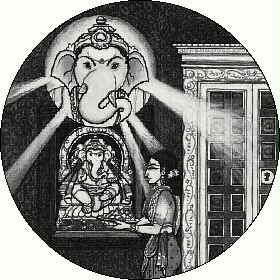
The Maha Ganapati Temple in Flushing, New York, began with two gentlemen from India who had been living in New York for several years. One of these hailed from a long line of temple builders; the other was a devout man who performed regular religious and yoga sadhana. This man had returned to India. He had a vision one night. He found himself soaring high above New York City until he came above an abandoned church in an area near his former residence. He came over the steeple, which opened as he moved down to land in front of the altar. Lo! there on the altar was Lord Ganapati Himself, who said nothing to him but just smiled. Immediately upon awakening, with his heart filled with love and the vision of the Great God still fresh in his inner mind, this sant phoned the temple builder who was then serving at the United Nations in New York. The temple builder asked him to come to New York right away. Travel arrangements were made, and within 24 hours the two of them were driving around the Queens section of New York in search of Lord Ganapati’s new home. They finally came upon the old Christian church that was the very one seen in the vision and which was for sale at the time! There could be no doubt that Lord Ganesha had come and had shown where to put His temple. The building was subsequently purchased. After many years of hard work, with the blessings and sanction of Shrilashri Pandrimalaiswami, Lord Ganesha was installed and consecrated in an orthodox shrine to receive traditional public worship.
Meanwhile, nearly halfway around the world on the Kona coast of the island of Hawaii in the Pacific Ocean, a small murti of Lord Ganesha was being worshiped at a seashore shrine by my Saiva Siddhanta devotees. A sixteen-year-old kumari girl who lived nearby had been performing regular daily puja and chanting at the site. Her devotion was blessed with several visions of the Deities Ganesha and Murugan. During April of 1980, at the time that new murtis of Lord Ganesha and Lord Murugan were being delivered to their temporary residence at another devotee’s home farther down the hillside, this young lady looked out from her home and saw the Lords Ganesha and Murugan walking in a circle of blue light up toward the seashore shrine. She described them as completely bedecked with flowers, Ganesha dressed in white and Murugan in orange. The Murugan murti was that of Palani, the renunciate, and this is how He appeared in the vision. She also reported having seen Lord Ganesha on two other occasions sitting serenely at the site of His new shrine, gazing silently at her with doe-like eyes.
Just a few months later, another of my devotees in Hawaii, an older woman who had been doing sadhana, was sitting in meditation when her satguru appeared before her. He started to ascend upward in this vision, and she clutched his robes and went up with him until her strength failed and she fell back down. Before she landed, Lord Ganesha caught her in His trunk and took her back up to where her satguru was seated in front of two large golden doors which opened into the world of the Gods. Lord Ganesha gently set her down on the threshold next to her beloved guru, she said.
Since 1972 many other devotees have seen Lord Ganesha in their visions and dreams. For example, several pilgrims on the 1981 India Odyssey, a spiritual pilgrimage to the holy lands of ancient Bharat (India), had life-altering visions of Lord Ganesha at the Shri Kumbalavalai Temple in Jaffna, Sri Lanka. Such visions of Lord Ganesha clarify much about the way this great Lord works. While the visions took place within the subtle minds of His devotees, or our microcosm, this subtle space is in fact enormous and quite a macrocosm of its own.
Just as Lord Ganesha’s vehicle, the tiny rodent, ferrets out every secret space and hidden area of the house, so does this Great Mahadeva have the ability to move within the seemingly most obscure and intricate areas of our minds. He is the master of both the big and the small, the macrocosm and the microcosm. Lord Ganesha’s great girth is the entire manifestation of all that is, of the five elements of earth, air, fire, water and ether. Thus, He pervades all, not from the outside in but from the inside out. He does not move to pervade, for all form in its purest state is together, not far apart. Seated unmoving on the broad, four-petalled lotus of the muladhara chakra, Lord Ganesha records and governs the movements of vast inner oceans of actinodic energy that appear to our physical eyes to manifest as forms so many millions of miles apart. He is at work through all the outwardly gross forms of nature, and yet mounted on his tiny mouse He can, in utter minuteness, travel about within His devotees’ minds as if they were great, well-lit caverns. Such is the mystery of the pompous elephant-faced God, the embodiment of form who rides the mouse.
During puja at the Madhaya Kailasa Temple in Chennai, devotees saw and continue to see Ganesha, the elephant God, and Hanuman, the monkey God, merging into one, as the alpha and omega of existence. To honor this unusual form, in 1993 a five-metal image, half Ganesha and half Hanuman, was created and enshrined. It all started with a series of early morning visions that graced devotees of the two unusual Gods in the great Hindu pantheon of 330 million.
The final vision to recite is one that I had in the mid-1980s of Lord Ganesha walking from His temple attended by two priests. He was about to take a bath in the beautiful Indian Ocean in the country of Mauritius where the river meets the sea. I was standing in the water with several sharks swimming around me. Lord Ganesha, accompanied by two priests, looked at me and said, “Just rub some oil on their noses and they will not harm you.” This vivid mystic experience is illustrated on the next page.
Remember, such visions of this great Lord do not come only to the meditating yogis, but to sincere bhaktas as well — those who by virtue of their sukarma receive this special grace at particularly auspicious times in their lives.
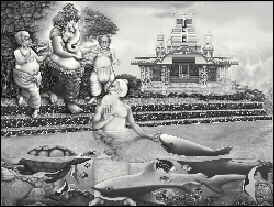
Our Loving Ganesha
Loving Ganesha is our friend indeed.
He is our protector,
The God we go to when in need.
Loving Ganesha knows our future and past.
He is our conscience,
The God we go to when we want to move fast.
Loving Ganesha is the God on our side.
He is immediate,
The God we pray to when we want to abide.
Loving Ganesha is our loving Lord.
He is our All,
The God that we shall all look toward.
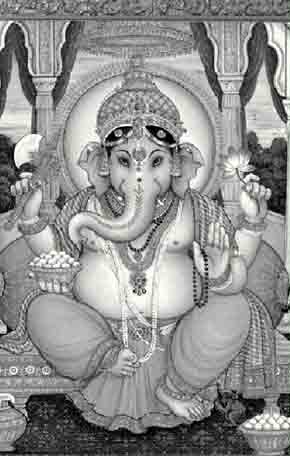
The Favorite God Of Maharashtra
 By Dr. S. Srinivasan, from Tattvaloka, Feb/Mar 1990
By Dr. S. Srinivasan, from Tattvaloka, Feb/Mar 1990
No other state in India dotes on its presiding Deity the way Maharashtra does Lord Ganesha. Every year the whole land reverberates with rhythm and music in praise of the Lord for ten days, starting with Ganesha Chaturthi and culminating in a grand, pompous immersion ceremony on Ananta Chaturdashi day. No wonder Maharashtrans cherish visiting the eight sacred temples of Vinayaka, known as the Ashtavinayaka, where the Lord’s image is said to have sprung up naturally, true to the word svayambhu. Logically, the images are devoid of elaborate ornamentation. They are stones showing only the broadest outlines of Lord Ganesha’s tusked face and trunk, heavily smeared with red sindur, applied layer over layer for centuries.
Lord Ganesha was brought decades ago to the heart of every Maharashtran by Bal Gangadhara Tilak as part of a socio-cultural movement directed against alien rulers. The momentum it has gathered is now for all to see. Despite intrusion of modern tastes and living habits among the younger generation, the deep roots that Ganapati worship has struck in the ethos of this tradition-loving state appear well set to stay for eternity. The eight icons are located in scenic spots scattered over three or four districts of Western Maharashtra. In the good old days, with the transport system not so well developed, visiting all of them took eight days or more; but today one can complete the pilgrimage in three days. There are several travel agencies in Pune that arrange safe and comfortable trips for the pilgrims. A brief resume of the shrines follows. Pilgrimage can be arranged through India embassies worldwide, each of which has access to efficient travel bureaus; and friendly help in arranging the pilgrimage will be gladly provided.
1. Morogoan Temple to Sri Mayuresvara
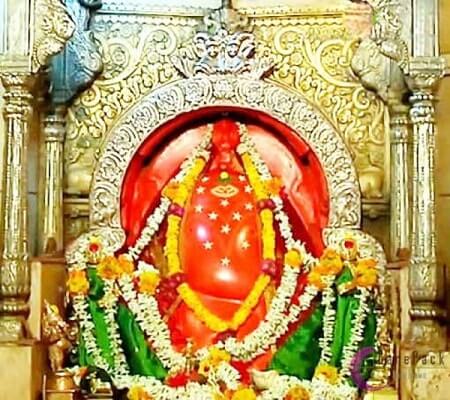
Let us begin with the most important of the eight holy places, Morgaon, situated about 65KM southeast of Pune and 16KM from the nearest railway station, Jejuri. Enclosed by tall stone walls forming a quadrangle, the temple here bears some semblance to Islamic architecture characterized by minaret-like towers in the four corners. Apparently it enjoyed the support of a benevolent Muslim chieftain for awhile. An interesting feature of this temple is the giant-sized stone Nandi positioned in front of the Lord. It is said that centuries ago, as the Nandi was being transported to a Siva temple nearby, it decided to settle in front of Lord Ganesha and just would not move. Within the quadrangle surrounding the temple there are eight smaller temples with Ganapati idols by the names Ekadanta, Mahodhara, Gajanana, Lambodara, Vikata, Nataraja, Dhumravarna and Vakratunda. There are also 23 other idols of various Gods from the Hindu pantheon, besides two sacred trees: bilva and shami. The sanctum sanctorum houses Mayureshvara [Peacock Lord], a primordial idol with a left-sided trunk, fully smeared with saffron and protected by the hood of a cobra. It is said that the actual image is quite small but it looks big due to the thick layer of saffron, which falls off once in a century or so. The local people believe that this happened last in 1882 and prior to that in 1788.
2. Thevoor Temple to Sri Chintamani
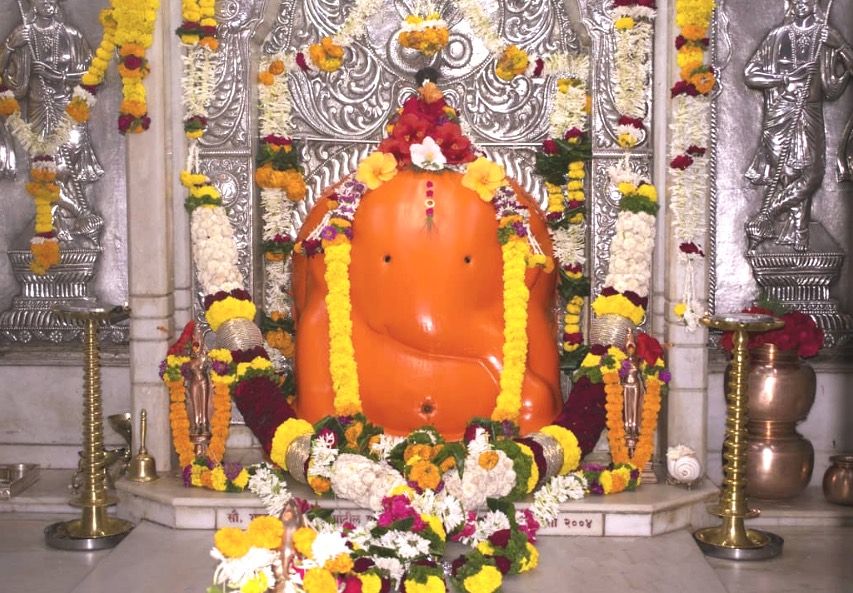
Situated 22kilometers from Pune, this village became the spiritual retreat of many a Peshawar ruler of Pune, especially Madhavarao the senior. Lord Ganesha here is known as Chintamani [jewel of consciousness]. The story behind this name relates to the Lord’s retrieving a precious stone (chintamani) for one of his devotees, Kapila Muni, from a greedy king, Gana. By then, however, Kapila Muni would rather have his Lord than the precious stone. The Lord thus chose to stay with his devotee as Chintamani himself. The conjoint river Mula-Mutha flows by the village as it winds its way to join Chandrabhaga, which in turn flows past Pandharpur to eventually join the Tungabhadra and the Krishna. Morya Gosavi, the great Ganesha devotee, used to pass through Thevoor on his trips between Chinchwad and Morgaon. The Lord’s icon, again smeared with sindur, is not much different from the others of the Ashtavinayaka group, with the features hardly visible, except the elephant head and trunk. But the divine impact on the devotees is potent as ever.
3. Siddhatek Village Temple to Sri Siddhi Vinayaka
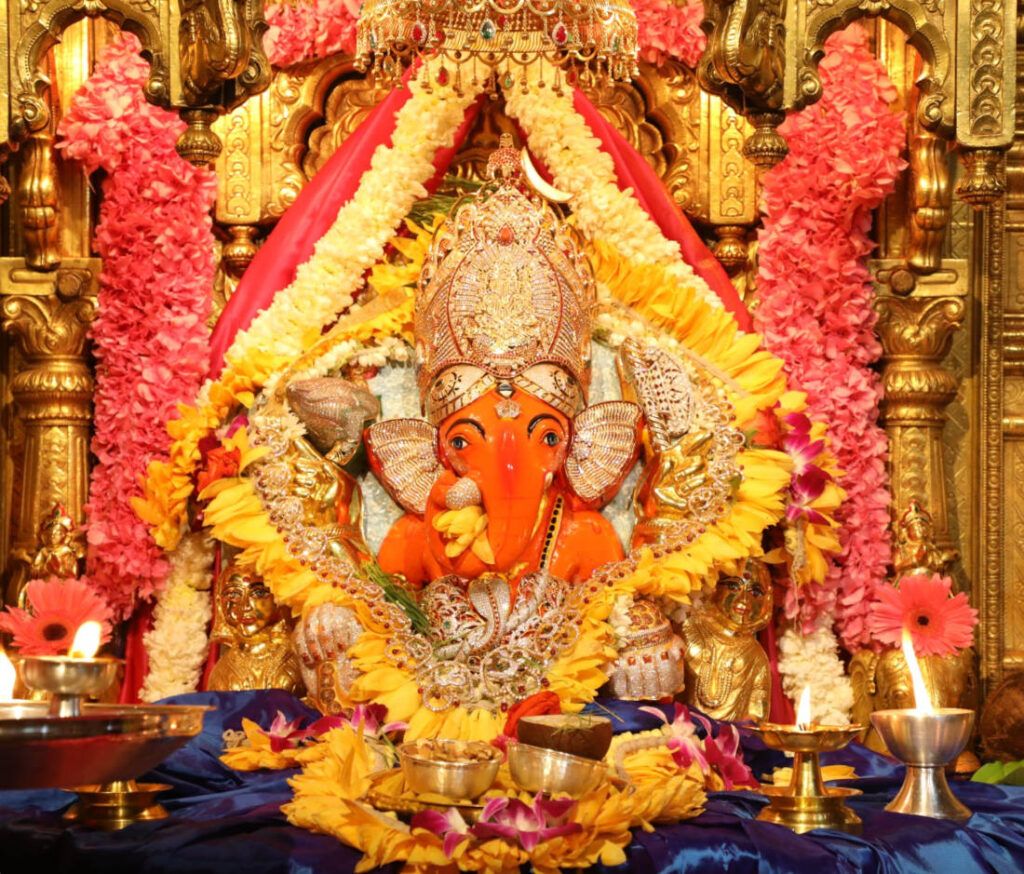
This village is 13kilometers northeast of Daund railway junction, but one has to cross the Bhima River by boat. Years ago, before a downstream dam was built, one could walk across the dry river bed; but today the waters are too deep. The idol of Ganesha here is right-tusked. Devotees are enjoined to be extra careful about the rituals and austerity while worshiping a right-tusked Ganapati [Siddhi Vinayaka, Masterful Remover]. The temple complex is atop a hill which stretches over a kilometer on the other side. Devotees seeking a favor from the Lord go around the entire hill seven times in pradakshina. With no footpath or road and with thorny bushes all around, this exercise — covering several kilometers of rough terrain — ought to bring the Lord’s mercy to the seeker!
4. Ranjangaon Shrine to Sri Ganapati
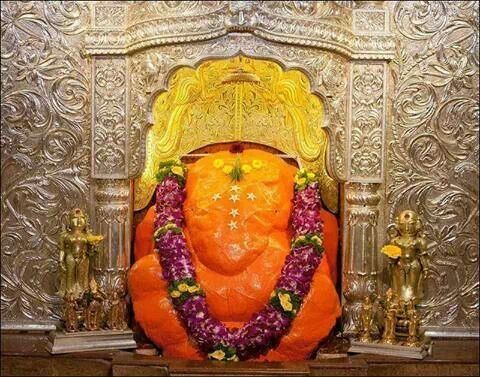
Located on the highway connecting Pune and Ahmednagar is the home of Shri Mahaganapati [Great Lord of Hosts]. Flanked by Buddhi and Siddhi, as his consorts are popularly known in Maharashtra, Shri Maha Ganapati of Ranjangaon can even enjoy the direct rays of the sun around noon time, thanks to the way the sanctum sanctorum is constructed. The icon of a ten-headed Ganapati known as Mahotkata is also housed in the temple complex but hidden from the view of most devotees. Some believe that once upon a time this was the main idol, but it was thereafter secretly hidden in fear of destruction invaders.
5. Ojhar Kshetra to Sri Vighnesvara
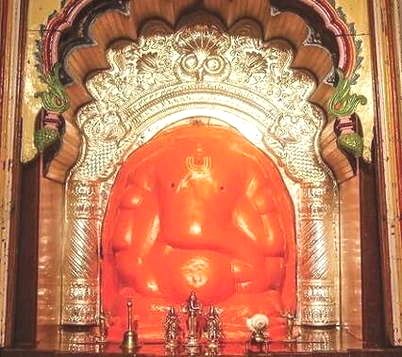
Just off the Pune-Nasik highway, this kshetra is ruled by Shri Vighneshvara [Lord of Obstacles], again flanked by Buddhi and Siddhi. Two smart dvarapalakas (sentries), a wide two-tiered prakaram, a well-polished figure of a mushika (mouse, the vehicle of Lord Ganesha) and two giant dipastambhas (lamp posts) all made of stone are the noteworthy features of this temple.
6. Lenyadhri Cave to Sri Girijatmaja
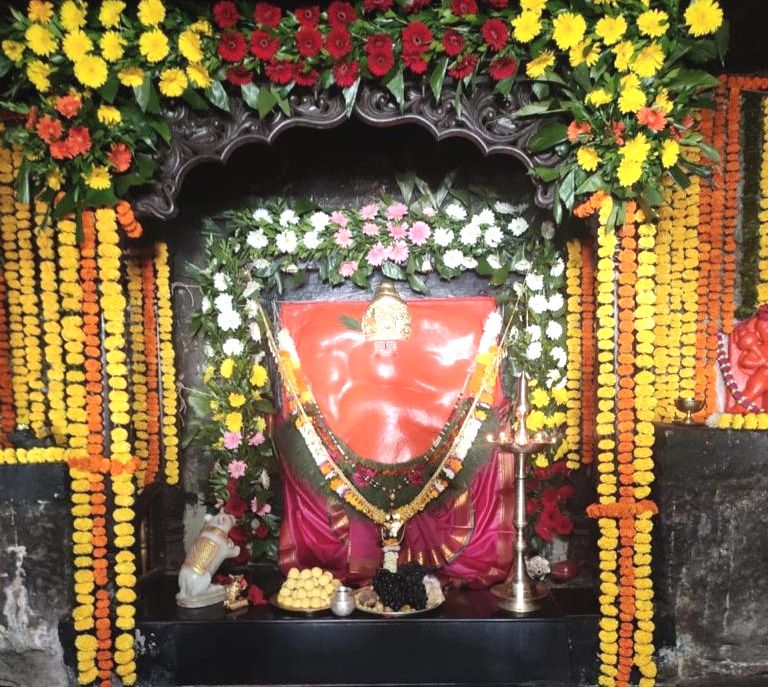
The name indicates a cave in a mountain. Ganesha as Shri Girijatmaja, “mountain-born,” enjoys a picturesque view of the landscape dotted with hills all around, merging into a mountain range beyond, and the Pushpavati River winding its way in between, glistening in the sunlight. After climbing 283 steps, one enters the temple, a single large room about 57 feet long and 51 feet wide, cut into the rock with no supporting pillars anywhere. There are 18 other caves of Buddhist architecture in this hill. This icon of Ganesha has even less distinct features than the others. The locals believe that it is only the back of Ganesha that is visible to the devotees and that the face is on the other side of the hill which is unapproachable. Some Peshawar rulers who tried to locate it were reportedly thwarted in their attempts.
7. Mahad Hamlet Temple to Sri Varada Vinayaka
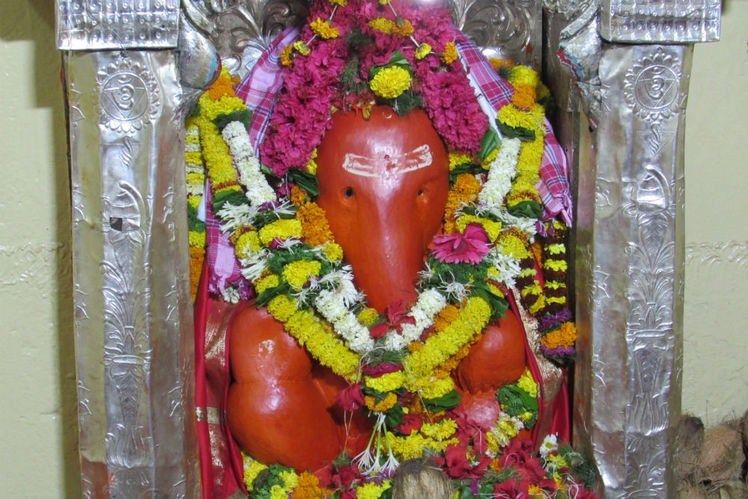
This is a tiny hamlet close to the Bombay-Pune highway near Khopoli, an industrial center. It is not to be confused with Mahad, a township on the way to Goa from Mumbai. The temple is located next to a tank that tends to go dry during summer, but the green fields and trees provide abundant cool air and a quiet atmosphere conducive to introspection and prayer. The sanctum is open to the public and, true to Maharashtran tradition, many devotees place their head right on the feet of the icon to seek blessings [of Varada Vinayaka, Lord of Boons]. An interesting feature of this temple is an anantadipa (eternal flame) that has been kept alight since 1892.
8. Pali Temple to Shri Ballaleshvara
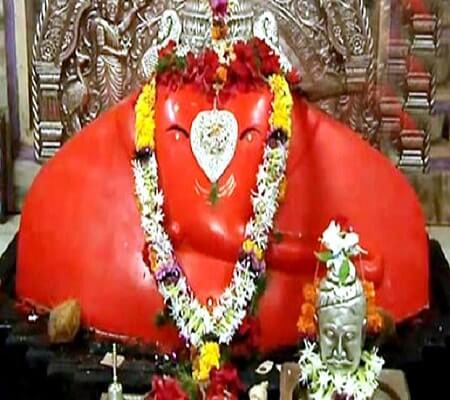
About 8kilometers off the Bombay-Goa highway, again set amidst a pleasant countryside dotted with hills and criss-crossed by rivers, one finds the village of Shri Ballaleshvara. The name comes from Lord Ganesha saving a boy named Ballala who even as a child spent all his time praying to Him. Angered by the boy’s obsessive behavior, the villagers beat him up mercilessly, and it was Lord Ganesha who intervened to save his life. There are two Ganesha temples here. One has first to visit Shri Dhundivinayaka, the idol which Ballala worshiped, before proceeding to Shri Ballaleshvara in the main temple. The idol in the latter is unusually broad and enjoys early-morning sun rays, as it sits facing the east, right at the foot of a steep hill. During the usually heavy monsoon months, waterfalls streak the landscape all around. A huge panchadhatu (five-metal) bell adorns the temple. Its sweet chimes add a special touch of music to the various aratis performed for the Lord.
Maharashtra’s Other Ganesha Temples

In addition to the famous Ashtavinayaka, Maharashtra boasts a bounty of Ganesha temples in every nook and corner, some famous, others not so. The more important ones include Shri Siddhi Vinayaka of Bombay; Shri Maha Ganapati (famous as a matrimonial matchmaker) at Titwala, 75KM from Bombay; Shri Mangala Murti at Chinchwad, a suburb of Pune; Shri Kasva Ganapati and Shri Sarasbag Ganapati, both of Pune city. On the Arabian sea coast, just off Ratnagiri, Ganapatipule houses a temple that is literally kept washed by the waves every day, an attraction for tourists and devotees. Other well-known temples are Dasabhuja Ganapati near Chiplun on the coastal belt, Siddhi Vinayaka at Nandgaon, Vighnayana Ganapati at Rakshasabhuvan in Marathwada, Modakeshvara at Nasik and Shri Ganapati at Seetabardi, Nagpur. Pilgrims who visit all the named temples during a single tirthayatra, spiritual outing, are said to have gained the ultimate blessing of the five-armed Lord. Those rare souls who add to this list more visits to His other abodes are assuredly kept in His heart forever, enjoying the bliss of all sweet things when in the hereafter, between births.

A List of Ganesha Temples Worldwide
Three great pillars have held Hinduism high, millenium after millenium: the satgurus, scriptures and the temples. Listed here are significant Ganesha temples we know of around the world, with place name followed by temple name or the murti inside the temple. We welcome submissions to expand this list for future printings of Loving Ganesha.
Temples in Maharashtra
Eight-Temple Pilgrimage
MORGAON
Mayureshvara — India’s foremost Ganesha pilgrimage
SIDDITEK
Siddhi Vinayaka
PALI
Ballala Vinayaka
MADHA
Varada Vinayaka
OJHAR
Vighneshvara
LENYADRI
Girijatmaja
RANJANGAON
Maha Ganapati
THEUR
Chintamani
Other Maharashtran Sites
ADOSHA, NAGAPUR AREA
Shami Vighnesha
BEROLA
Laksha Vinayaka
JETHA KAPAD MKT, BOMBAY
Siddhi Vinayaka
KALAMBA
Cintamani Ganesha
KANAKESVARA
Rama Siddha Vinayaka
KASVA
Jayate Ganesha
NAGAJHARI RIVER
Trishunda
NAMALGAON
Amalashramakshetra (famous for prayers)
NANDED
Citrakuta Ganesha
NASIK
Higalyaka Ganapati
PADMALAYA
Pravalakshetra with two Ganesha murtis
PRABHA DEVI, BOMBAY
Siddhi Vinayaka
RAJUR
Rajasadanakshetra
RAKSHASABHUVAN
Vijna Ganesha
SANGLI, KRISHNA RIVER
Ganesha (a svayambhu Ganesha installed over a Sivalinga)
TITWALA
Siddhi Vinayaka Maha Ganapati (a place of miracles)
Temples in Uttar Pradesh
PRAYAGA
Omkara Ganapati
VARANASI
Dhundhiraja Ganesha
Temples in Orissa
CHANDIKHOLE, CUTTACK
Maha Vinayaka
Temples in Kerala
TIRUVANANTHAPURAM
Shri Agrasala Ganapathy
Temples in Tamil Nadu
AMBAL
Suddu Vinayaka
ANBILALANTURAI
Sevisaitta Pillaiyar
CHIDAMBARAM
Katpaka Vinayaka
KUDANTAI KIRKKODDAM
Gangai Ganapati
KALATI
Manjanti Vinayaka
KANCHIPURAM
Valampuri Vinayaka, Vikada Chakra Vinayaka
MADRAS, PERIAMEDU
Shri Varasiddhi Vinayaka
MADURAI
Mukkuruni Pillaiyar
Siddhi Vinayaka
MAYURAPURAM
Mayuresha Vinayaka
NAGAPADDINAM
Pancha Mukha Vinayaka
PONDICHERRY
Manakkula Pillaiyar
SENPAKKAM
Temple of eleven svayambhu Ganeshas
SIRGALI
Aapattukatta Vinayaka
TIRUCHIRAPPALLI
Uchi Pillaiyar
TIRUINNAMPAR
Nirutana Vinayaka
TIRUKKACHYUR
Talamula Vinayaka,
Karukkadi Vinayaka
TIRUKKADAVUR
Kallavarana Pillaiyar
TIRUKKARUVIL
Kadukkai Vinayaka
TIRUKODDAIYUR
Kodi Vinayaka
TIRUKOKARNAM
Maha Ganapati
TIRUMAKARAL
Poyya Vinayaka
TIRUMALAPADI
Sundara Ganapati
TIRUMARAIKADU
Veeragati Vinayaka
TIRUMURUGANPUNDI
Kuppidu Pillaiyar
TIRUNADDIYATANKUDI
Kaikaddi Vinayaka
TIRUNALLUR
Salakkirama Vinayaka
TIRUNALLARU
Sorna Vinayaka
TIRUNARAIYUR
Polla Pillaiyar
TIRUNTUTEVANKUDI
Karkadaka Vinayaka
TIRUPATTUR
Maya Pillaiyar
TIRUPPANAIYUR
Tunaiyirunta Pillaiyar
TIRUPPURAMPAYAM
Piralayangkatta Pillaiyar
TIRUVAIYARU
Adi Vinayaka
TIRUVALAM
Valam Vanda Vinayaka
TIRUVALAMSULI
Vellai Pillaiyar
TIRUVARUR
Vatapi Vinayaka
TIRUVAVADUTURAI
Sivaprakasa Vinayaka
TIRUVETIKUDI
Veta Pillaiyar
TIRUVIDAIMARUTUR
Anda Vinayaka
TIRUVILIMILALAI
Padikkasu Vinayaka
TIRUVUSATANAM
Kutavana Pillaiyar
VALLAM
Varasiddhi Vinayaka
VIRUTTASALAM
Mattru Uraita Pillaiyar
Temples in Sri Lanka
Temples in Jaffna
CHULIPURAM
Kannaikothikakkai Pillaiyar
INUVIL
Karunakara Pillaiyar
MANIPAY
Maruthady Vinayagar
MURUKANDI
Murukandi Pillaiyar
NALLUR
Kailasa Pillaiyar
NEERVELY
Arasakesari Pillaiyar
Temples Outside Jaffna
ALAVEDDY
Kumbalavalai Pillaiyar
BATTICALOA
Mamanga Pillaiyar
COLOMBO, CHETTY STREET
Shri Muthu Vinayaga Temple
COLOMBO, BAMBALAPITIYA
New Kathiresan Temple
KANDY
Selva Vinayaka
KATIRAGAMA
Manikka Vinayaka
Temples in Nepal
Temples in Kathmandu Valley
BHAKTAPUR
Surya Vinayaka
BUNGAMATI
Karna Vinayaka
CHOBAR
Jal Vinayaka
KATHMANDU
Ashoka Vinayaka
Chandra Vinayaka
Temples Outside Kathmandu Valley
GORKHA
Vijaya Ganapati
JANAKPUR
Rama Temple
Siddha Ganesha
PHULAHARA
Rama/Janaki Temple
Girija Ganesha
Temples in Cambodia
KANDALA
Padmasana Ganesha
Temples in Malaysia
Temples in Kuala Lumpur Vicinity
JALAN BRUNEI/PASAR
Shri Siddhi Vinayaka
JALAN IPOH
Shri Paranjothi Vinayaka
KUALA KUBU BARU
Shri Sithivinayaka
JALAN PPUDU LAMA
Shri Ganeshan
Temples Outside Kuala Lumpur
BEHRANG ULU, PERAK
Siddhi Vinayaka
IPOH
Shri Maha Ganapati
KLANG
Siddhi Vinayaka
SANDAKAN, SABAH
Siddhi Vinayaka
SITIAWAN, PERAK
Siddhi Vinayaka
Temples in Singapore
CEYLON ROAD
Shri Senpaga Vinayaka
KEONG SIAK ROAD
Shri Vinayaka
Temples in Australia
MAGILL
Ganesha
MELBOURNE
Vakratunda Vinayaka
Temples in South Africa
DURBAN, NATAL
Sithi Vinayaka
LADYSMITH, NATAL
Ganesher
MT. EDGECOMBE, NATAL
Ganesha
Temples in Germany
HAMM
Siddhi Vinayaka
HALTINGEN
Vara Siddhi Vinayaka
HEILBRONN
Vinayaka
Temples in France
PARIS
Shri Manikkavinayakar Alayam
Temples in United Kingdom
LONDON, EFFRA ROAD
Shri Ganapati
Temples in United States
ANCHORAGE, ALASKA
Shri Ganesha
FLUSHING, NEW YORK
Shri Maha Vallabha Ganapati Devasthanam
NASHVILLE, TENNESSEE
Shri Ganesha
PHOENIX, ARIZONA
Shri Ganesha
SALT LAKE CITY, UTAH
Shri Ganesha
SEATTLE, WASHINGTON
Hindu Temple
Shri Ganesha
Temples in Canada
EDMONTON
Maha Ganapati
Temples in Indo-China
Ganesha has few of his own temples in these lands, tens of thousands of small Ganesha images are found everywhere, and one or two larger images. He was worshiped in the Saivite tradition that covered these areas as early as 400CE.
Temples in Bali/Indonesia
While we do not find temples dedicated specifically to Ganesha, He is found in almost every Siva shrine throughout the islands.
**Credits to and published by Himalayan Academy

